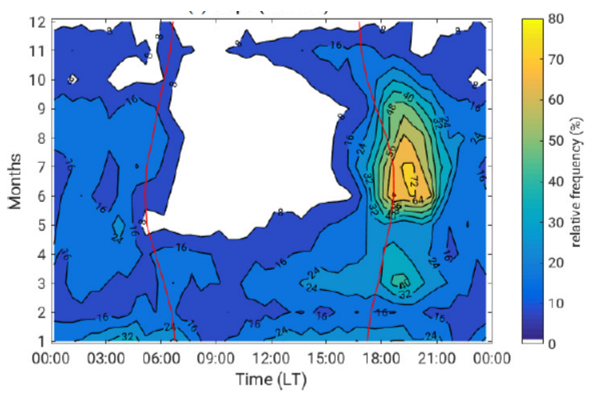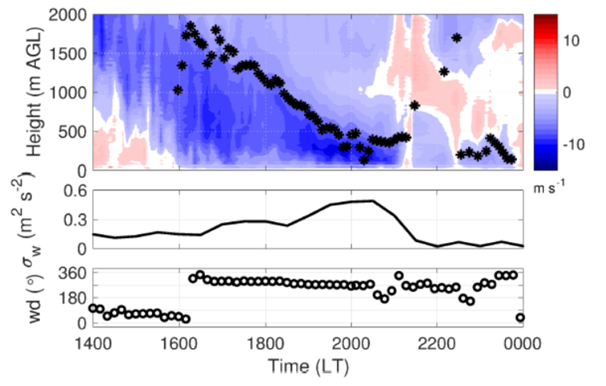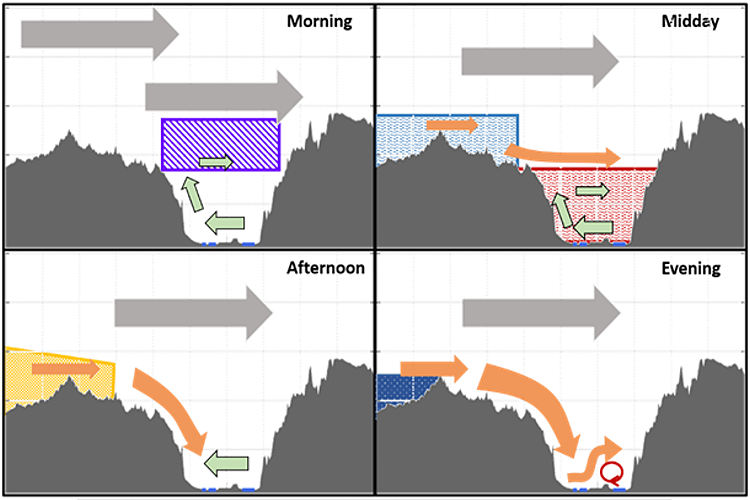Foehn winds at the Dead Sea! How can this happen?
The effects of frequently occurring foehn wind on weather, climate and air quality in the Dead Sea valley is investigated by the Virtual Institute DESERVE (Dead sea Research Venue) of the Helmholtz Association.
A density-driven flow, which accelerates and warms while descending into a valley (Alpert et al., 1990) is called a foehn wind, when following the definition of the World Meteorological Organization (WMO, 1992), which does not take diabatic processes into account. At the Dead Sea foehn occurs most frequently in summer and enters the valley after sunset. These foehn events have a large impact on the atmospheric conditions in the valley due to their high wind velocities and adiabatic heating of the air mass during the descent into the valley. The foehn events influence the lake evaporation, as evaporation is driven by wind velocity and water vapour pressure deficit (Metzger et al., 2018). The diurnal maximum of evaporation is reached, untypically, shortly after sunset when the foehn sets in. Finally, the foehn events can also cause an air mass exchange and remove the often occurring haze layer from the valley and thus improving air quality.
| Fig. 1: Relative frequency of foehn occurrence of more than 72 % in the central part of the Dead Sea valley calculated by the model of Plavcan et al. (2014). Sunrise and sunset are marked as red lines. | Fig. 2. Example for a strong foehn event at 16 August, 2014, in the central Dead Sea valley. Time-height cross sections of the averaged vertical profiles of the horizontal radial wind component derived from lidar RHI scans. Negative values (blue colours) indicate a wind component from north-west and positive values (red colours) indicate a wind component from south-east. Black stars indicate the height of the foehn. Below the cross section the variance of the vertical wind (σw) at 2 m agl and wind direction (wd) measurements in 40 m height are shown. |
For the first time, sophisticated, high resolution measurements were performed by IMK of KIT to investigate the horizontal and vertical flow field. In up to 72 % of the days in summer, foehn was observed at the eastern slope of the Judean Mountains around sunset (Fig. 1). Furthermore, the results also revealed that in approximately 10 % of the cases the foehn detached from the slope and only effected elevated layers of the valley atmosphere. Lidar measurements showed that there are two main types of foehn. Type I has a duration of approximately 2-3 h and a mean maximum velocity of 5 m s-1 and it does not propagate far into the valley, whereas type II propagates across the valley to the eastern side. Type II reaches mean maximum wind velocities of 11 m s-1 and has a duration of about 4-5 h (Fig. 2).
| Fig. 3: Conceptual model describing the different boundary layer processes in the valley on 16 August 2014. The wind systems (arrows) and the ongoing processes (shaded areas) leading to the next stage for morning, noon, afternoon, and evening are highlighted. |
A case study shows that foehn is initiated by the horizontal temperature gradient across the mountain range. This is caused by an amplified heating and delayed cooling of the valley boundary layer in the afternoon, compared to the upstream boundary layer over the mountain ridge. The foehn was further intensified by the advection of cool maritime air masses upstream over the coastal plains leading to a transition of subcritical to supercritical flow conditions downstream and the formation of a hydraulic jump and a rotor (Fig 3). These foehn events are of particular importance for the local climatic conditions, as they modify the temperature and humidity fields in the valley and, furthermore, they are important because they enhance evaporation from the Dead Sea and influence the aerosol distribution in the valley.
Contact: ulrich corsmeier ∂does-not-exist.kit edu
[Working group: Convective Systems]



